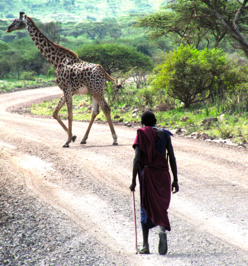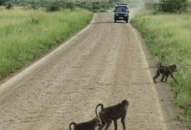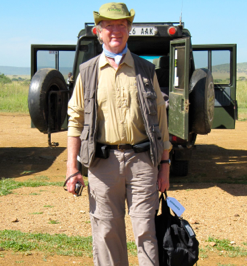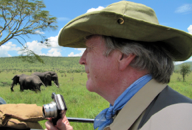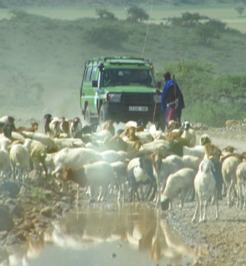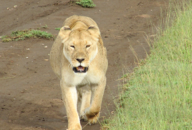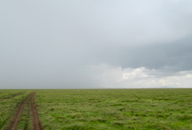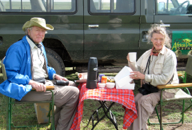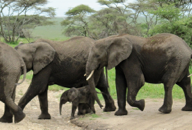african safari
african dream safari
serengeti national park, seronera, the gol, the serengeti plains,
lake ndutu, naabi hill, Olduvai Gorge, ngorongoro crater & lake manyara
tanzania, east africa
february 19 - 26, 2010


african safari
african dream safari
serengeti national park, seronera, the gol, the serengeti plains,
lake ndutu, naabi hill, Olduvai Gorge, ngorongoro crater & lake manyara
tanzania, east africa
february 19 - 26, 2010


The CEO of African Dream Safaris, Michael Wishner, wrote a personal message to their guests in the company’s stunning catalogue. He stated, “Imagine endless savannas teaming with millions of wildebeest, towering boulders sprawling tawny lions and collapsed volcanos brimming in mist. Imagine a place completely unaware of civilization where wildlife still reigns supreme. It is hard to believe a place like this still exists, but it does. It is called Tanzania. The first time I experienced this wilderness, it captured my soul. I felt compelled to share this experience with others. This calling, this passion, this dream was the start of African Dream Safaris”. This statement describes our experience on safari with this outfitter in Tanzania, a marvelous private tour lasting eight days. Henry and I are still stunned by the beauty of the landscape we saw, the numbers of animals we encountered, and the amount we learned from our guide. The list of game went far beyond the “Big Five”: elephants, rhinoceroses, lions, cheetahs, and leopards, to include Cape buffalos, hippopotamuses, zebra, wildebeest, giraffes, as well as antelopes and gazelles of several varieties. Warthogs, hyenas, and smaller mammals such as baboons, monkeys, mongoose, and jackals were also fascinating to spot in these territories. This marvelous safari experience included the micro as well as the macro, where the vegetation: grasses. trees and flowers, and flying creatures: birds, butterflies, and insects, all played important roles in the overall ecological pattern of the Serengeti and beyond. African Dream Safaris company was chosen by National Geographic as the BEST Safari Outfitter in 2009. They were also awarded the Tanzanian Humanitarian Award in 2009, and the Tanzanian Conservation Award in 2008. Based on these accolades, Henry and I had the confidence to choose this company amongst a field of more than fifty other safari outfitters operating in Tanzania. We were pleased with our decision, and could highly recommend African Dream Safaris to deliver an extraordinary and unforgettable safari experience. Our safari dream was to witness the wildebeest migration on the plains of the Serengeti. Two million of these animals spend months here feeding on the grasses nourished by the volcanic soil. February, was a great time to be here as it coincided with the calving of wildebeest, as well as the births of zebras and giraffes. However, the migration of the wildebeest is a constant cycle throughout the year, and this migration can also be witnessed in the north and west of Tanzania and in southern Kenya in other seasons. The movement of the animals depends on the weather, especially the rains which turn the grass green and leave pools of water for the animals. Therefore, “rain means game”.
•December - April: South and Eastern Serengeti.
•May - June: Central and Western Serengeti.
•July - November: North Serengeti.
A note on photography:
Henry and I had the most amazing time on our safari, taking thousands of photos. I took 5,000 and Henry took 1,500. We bought new cameras for the trip in order to insure that we recorded this experience and could share it with you. These cameras were purchased in Dubai at the Canon Store in the Dubai Mall. The PowerShot SX200IS has an optical zoom lens with a closeup capacity range from 5.0-60.0, all housed in a pocket sized camera. We were amazed to see the crisp images, with fine detail that included the soft white hairs on the underbelly of a baby elephant, for example, supported by the camera’s built-in stabilizer. Whether I was shooting through the open window on safari, or standing with my camera perched on a balance bag as I shot scenes through the open rooftop, the results were the same. I admit that the big zoom lenses I saw in other safari vehicles gave me just a little lens envy. However, I was neither willing nor able to manage the weight or the volume of the single lens reflex cameras, especially since Henry and I haul all our tech stuff with us as we constantly travel throughout the world. How lucky that our safari was timed just two months after these new Canon cameras were introduced. We each now travel with 3 small cameras including our original Canon 750SD and an Olympus U1050SW underwater camera, good for depths of 3 meters/9.8 feet.
PHOTOS: Left Column: 1. Henry and Jourdan, having a picnic breakfast on the Serengeti Plain. 2. A lioness, approaching our safari vehicle as we were stopped in our tracks on the Serengeti Plain. 3. Crossing a bridge over the Banagi River. 4. A zebra on the Serengeti Plain crossing the the tracks of the safari vehicle as we explore the territory. 5. The rain on the plain with safari tracks determining our path. 6. Jourdan photographing elephants from her seat of the spacious 8-seat safari vehicle. Center, Top: Masai herdsman and goats on the road near the Olduvai Gorge. Center, Middle: Henry, upon our arrival by plane in Seronera. We had just met Wilfred, our game driver and guide, who was loading our gear into the safari vehicle in the background. Center, Bottom: On the road out of the Ngorongoro Crater. Masai tribes lived in the area, indifferent to the giraffe crossing the road. Right Column: 1. Henry, standing in the safari vehicle while photographing the herd of elephants in Seronera. 2. A troop of baboons crossing a road in front of our vehicle, as another safari vehicle approaches at breakneck speed. 3. Thousands of wildebeest on migration with zebras amongst them graze on the grasses of the Serengeti Plain. Those crossing the safari track clear the road as we approach them. 4. A view across the savanna, where a line of wildebeest advance in migration. 5. All safari vehicle traffic stopped as a huge herd of elephant, including many baby elephants, crossed the road. 6. Jourdan, showing two Masai their images on the digital screen of her camera. One was a married woman with a baby on her back, the other a girl. Both were amazed as we were the first “European” types who had visited their village on the Olkariani Plains , beyond the boundaries of Serengeti National Park.

On & Off-Road in the Wild

